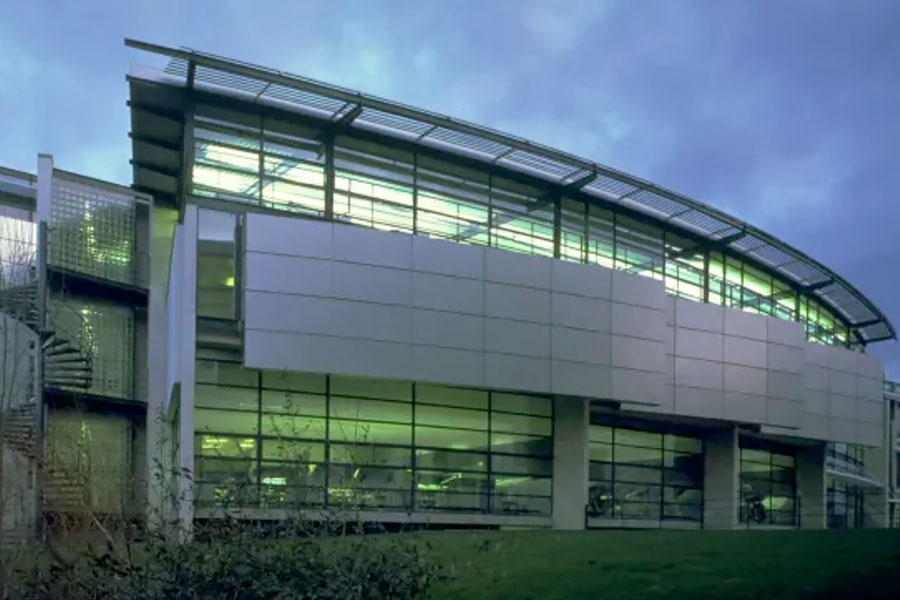A prizewinning building, once celebrated as Britain’s “best,” will be reduced to rubble if the university that owns it has its way.
The Centenary Building, once the glass-and-concrete triumph of the University of Salford, outside the northern city of Manchester, was the inaugural winner of the Royal Institute of British Architects Stirling Prize in 1996. The prize recognizes the best new building in Britain.
Barely 29 years later, the building has become a white elephant. Its critics say it is too hot in the summer, too cold in the winter, and too noisy all year. Its “aging infrastructure means it no longer meets modern standards and requirements,” the University of Salford said in a brief statement, adding that it has “been vacant for a third of its built life.”
But the decision to level it has pitted preservationists against pragmatists. Architecture buffs are rushing to get the Centenary Building listed as a historic site, which could spare it from the wrecking ball.
The university, on the other hand — along with the Salford City Council and a real estate developer called the English Cities Fund — wants to demolish the building to make way for a $3.2 billion new city district to be known as the Crescent. The school, with more than 26,000 students, and its partners see the project as a key to fostering economic growth in the area.
Opponents of the plan include the Twentieth Century Society, an organization aimed at preserving Britain’s design heritage. “This is a sophisticated piece of modern architecture, with clear opportunities for adaptive reuse,” the society said in a statement, urging the university to reconsider. “It acted as catalyst for previous regeneration in the area, and could do so again.”
When the Centenary Building was completed in 1995, it was a celebrated for its wide interior spaces with indirect sunlight. When commissioning the building, the university called for a structure that would be a “fusion of design and technology,” according to the architect’s brochure. The Stirling Prize jury described it as “a dynamic, modern and sophisticated exercise in steel, glass and concrete.”
At the time, the building’s architects, Hodder+Partners, experimented with natural ventilation as an early energy-saving technique, forgoing the need for air-conditioning, Stephen Hodder, the head architect, said in an interview. Now, the building’s fluctuating temperature is one of the main complaints against it.
But it’s a design flaw that could easily be fixed by retrofitting the Centenary Building with new, more sustainable fixtures, Hodder said. “It shouldn’t be retained simply because it won a certain prize,” he said, arguing instead that it should be retained out of a responsibility to reduce its carbon footprint with sustainable design.
The Stirling prize catapulted to fame his then-fledgling architecture firm of six people. Hodder+Partners went on to win another prize, the Civic Trust Award, in 1998. Today, it employs 30 and enjoys the prestige of a major firm.
When Hodder received the commission, the building was a 1960s-era academic structure with an interminable corridor and barely any natural light. He envisioned that the new design would mimic a mall or medieval street, with classrooms and laboratories opening up onto an atrium.
His instructions were to build quickly and affordably. Midway through, the plans had to be adjusted from housing the department of electrical engineering to the faculty of art and design. As the glass, steel and concrete went up, the university’s leadership at the time decided the building’s unveiling would also mark the centenary of the school’s founding.
In the years since, however, the university has centralized its campus, and academics and students have abandoned the building. The university rented it out for several years but it has also stood vacant. Critics have characterized its rapid construction as rushed and shoddy
Efforts to turn the building into a school, with Hodder’s help, came to nothing, he said. He has also abandoned hopes that it could be used as a community health center.
“I’m trying to detach myself from the importance of that building to this practice,” Hodder said, adding that he learned about its planned demolition from news reports.
While Hodder says he has not joined any campaigns to save the building, the Twentieth Century Society is trying to whip up momentum. Last month, the society caught wind of the plan to demolish the Centenary building, said Oli Marshall, the society’s director of campaigns. The society and its trustees are among those seeking a historic site designation.
The university and its development partners — the City Council and real estate development company — did not respond to questions about why the building could not be repurposed.
The Twentieth Century Society sees its bid to have the building granted protected status as a test case for prizewinning architecture. If buildings that have been lauded for their contribution to British architecture “only have a shelf-life of 30 years, what does that say about the current state of British architecture?” the group said in its statement.
The New York Times News Service











